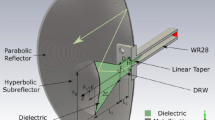Abstract
Periodic and quasi-periodic structures printed on a dielectric substrate can be employed to control reflection and transmission properties of incident waves as a function of structure geometry. This can be done mostly independently for both polarizations. These structures thus allow the realization of different kinds of filters and polarizers. Local variation of the element geometry on a substrate with backside metallization — resulting in respective variations of the reflection phase angle — can be employed to design printed reflectarray antennas. Including the dual polarization properties of such antennas, dual function or dual frequency antennas can be built, or these properties can be exploited for the realization of compact, low-profile folded reflector antennas. Examples for a number of antennas are presented, including dual radiation characteristics, dual frequency operation, and very compact, low loss folded reflector antennas
Résumé
Des structures périodiques et quasi-périodiques, imprimées sur un substrat diélectrique peuvent être employées pour commander les propriétés de réflexion et de transmission des ondes incidentes en fonction de la structure géométrique. Ceci peut être réalisé pratiquement indépendamment pour les deux polarisations. Ainsi des structures périodiques permettent la réalisation de différents types de filtres et de polariseurs. Des variations locales de la géométrie des éléments sur un substrat avec une métallisation sur la face arrière — ayant pour résultat des variations du déphasage par réflexion — peuvent être employées pour concevoir des réflecteurs à motifs imprimés (reflectarray antennas). En tenant compte des propriétés des deux polarisations pour de telles antennes, on peut construire des antennes à double fonction ou bifréquences, mais ces propriétés peuvent aussi être exploitées pour la réalisation ďantennes à réflexion indirecte (folded reflector antennas) de faible épaisseur. Des exemples ďantennes à double fonction ou bifréquences et ďantennes à réflexion indirecte à faibles pertes sont présentés.
Similar content being viewed by others
References
Russell (M.E.) et al., Millimeter-wave radar sensor for automotive intelligent cruise control (ICC),ieee Trans. Microw. Theor. Techniques mtt-45 (1997), pp. 2444–2453.
Mansen (D.), Villino (G.), Planar Microstrip Antennas for mmds Application at 40 GHz. 28thEuropean Microw. Conf. 1999, Munich, Germany, Vol. III, pp. 9–12.
Sehm (T.), Lehto (A.), A.V.Räisänen (A. V.), A high-gain 58 GHz box-horn array antenna with suppressed grating lobes,ieee Transactions on Antennas and Propagation,47, n° 7, 1999, pp. 1125–1130.
Anderson (T. N.),Michalski (J.),Hou (Yun-Li), A high power, high performance planar slot array antenna,Microw. Journal, May 1995, pp. 70–77.
Ando (M.) et al., Novel single-layer waveguides for high-efficiency millimeter-wave arrays,ieee Trans, on Microw. Theory Tech., mtt-46 (June 1998), pp. 792–799.
Dolp (R.), Mayer (W.), Grabherr (W.), 58GHz High Gain Flat Panel Antenna for High Volume Production,28th European Microw. Conf. 1999, Munich, Germany, Vol. III, pp. 12–15.
Mittra (R.) et al., Techniques for analyzing frequency selective surfaces — a review,Proceedings of the ieee,76 (12), pp. 1593–1615, Dec. 1988.
Munson (R.E.),Haddad (H.A.),Hanlen (J.W.), Microstrip Reflectarray for Satellite Communication and Radar Cross-Section Enhancement or Reduction, US Patent n° 4,684,952, Sept. 24, 1982.
Huder (B.),Menzel (W.), Flat printed reflector antenna for mm-wave application,Electronics Lett. 1988, p. 318.
Guo (Y.J.), Barton (S.K.), A High-Efficiency Quarter-Wave Zone Plate Reflector,ieee Microwave and Guided Wave Letters,2, 1992, 470–471.
Guo (Y. J.), Barton (S. K.), Fresnel Zone Plate Reflector Incorporating Rings,ieee Microw. and Guided Wave Letters,3, 1993, 417–419.
Javor (R. D.), Wu (X.-D.), Chang (K.), Design and performance of a microstrip flat reflectarray antenna,Microwave And Optical Technology Letters,7, n° 7, May 1994, pp. 322–324.
Menzel (W.), A planar reflector antenna,miop 1995, Sindelfin-gen, Germany, pp. 608-612.
Pozar (D.M.), Targonski (S.D.), Syrigos (H.D.), Design of millimeter wave microstrip reflectarrays,ieee Trans. on Antennas and Propagation, Vol. AP-45 (1997), pp. 287–96.
Patel (M.),Thraves (J.), Design and development of a low cost, electronically steerable, X-band reflectarray using planar dipoles,Military Microwaves, 1994, pp. 174–178.
Bradley (J.),Cuhaci (M.),Shaker (J.),Jetté (S.),Petosa (A.), A novel bifocal dual-frequency, dual orthogonal polarization planar reflector for SatCom applications,AP2000, Davos, April 2000, Session 5A2 (paper 0774).
Encinar (J.A.),Zornoza (J.A.), Design and Development of Multilayer Printed Reflectarrays for Dual Polarisation and Bandwidth Enhancement,AP2000, Davos, April 2000, Session 4A9 (paper 0236).
Pilz (D.),Menzel (W.), Full Wave Analysis of a Planar Reflector Antenna,1997 Asia Pacific Microwave Conf. APMC’97, Dec. 2-5, 1997, Hong Kong, pp. 225–227.
Pilz (D.), Menzel (W.), A mixed integration method for the evaluation of the reaction integrals using the spectral domain method,ieee Proc. on Microwaves, Antennas and Propagation,146, n° 3, June 1999, pp. 214–218.
Pilz (D.), Menzel (W.), Folded reflectarray antenna,Electron. Lett.,34, n° 9, April 1998, pp. 832–833.
Pilz (D.), Menzel (W.), A novel linear-circular polarization converter,28th Europ. Microw. Conf., 1998, Amsterdam,2, pp. 18–23.
Menzel (W.), Pilz (D.), Leberer (R.), A 77 GHz fm/cw radar front-end with a low-profile, low-loss printed antenna,ieee Trans. on Microw. Theory Tech.,47, n° 12 (Dec. 1999), pp. 2237–2241.
Menzel (W.),Pilz (D.), Printed quasi-optical mm-wave antennas.Millenium Conf. on Antennas and Propagation AP2000, Davos, Switzerland, 2000, Session 3A2-1 (paper n° 0023).
Menzel (W.), Pilz (D.), Printed mm-wave folded reflector antennas with high gain, low loss, and low profile,ieee Antennas and Propagation Conf. 2000, Salt Lake City, USA, July 2000,2, pp 790–792.
Itoh (T.) (editor),Numerical Techniques For Microwave And Millimeter-Wave Passive Structures. John Wiley & Sons, 1989.
Author information
Authors and Affiliations
Rights and permissions
About this article
Cite this article
Pilz, D., Menzel, W. Printed millimeter-wave reflectarrays. Ann. Télécommun. 56, 51–60 (2001). https://doi.org/10.1007/BF03002985
Received:
Accepted:
Issue Date:
DOI: https://doi.org/10.1007/BF03002985
Key words
- Reflector antenna
- Printed antenna
- Millimetric wave
- Periodic structure
- Orthogonal polarization
- Telecommunication application




